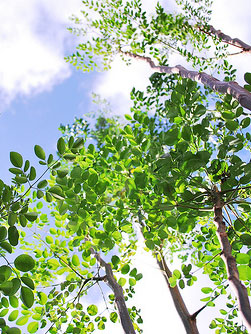The Moringa Tree

Every part of the Moringa tree is said to have beneficial properties that can serve humanity in one form or another. Over the years, many discoveries have been made by using various parts of tree to treat all kinds of ailments.
With the great success in treating medical issues, people in societies around the World have made use of these properties to promote good health.
Overall, you will find that parts of the Moringa tree has beneficial uses, some parts of the tree have more concentrated as others.
The amazing thought is every part of the tree in science is being discovered as useful!
- Leaves
- Fruits and Pods
- Flowers, Roots and Oils
Medicinal Uses
- Leaves
- Leaves applied as poultice to sores
- Treatment of headaches by rubbing leaves on the temples
- Digestive promotion from Moringa leaves, bark and roots
- Remedies for tumors (including abdominal tumors)
- Leaves are reported to contain 7.5g Water; 6.7g Protein: 1.7g Fat; 14.3g Total Carbohydrate; 0.9g Fiber; 440mg Calcium; 70mg Potassium; 7mg Iron; 110mg Copper, 5.1mg Iodine; 11,300 IU Vitamin A; 120mg Vitamin B; 0.8mg Nicotinic Acid; 220mg Ascorbic Acid, and 7.4mg Tocopherol.
- Estrogenic substances, including the anti-tumor compound, B-Sitosterol and Pectinesterase are also reported.
- Leaf amino acids include 6.0g Arginine/16g Nitrogen; 2.1g Histidine; 4.3g Lysine; 1.9g Tryptophane; 6.4g Phenylalanine; 2.0g Methionine; 4.9g Threonine; 9.3g Leucine; 6.3g Isoleucine, and 7.1g Valine.
Chemical Compound per 100mg
Medicinal Uses
- Fruits and Pods
- The unripe pods act as a preventive against intestinal worms
- The fruit is sweet and pungent in taste, an appetizer preventing eye disorders and increasing semen both qualitatively and quantitatively
- The fruit are used for curing articular pains, tetanus, nervous debility, paralysis, pustules, patches and leprosy
Chemical Compounds per 100mg
- From Pods - per 100g
- The pod is reported to contain 86.9g Water; 2.5g Protein; 0.1g Fat; 8.5g Total Carbohydrate; 4.8g Fiber; 30mg Calcium, 110mg Potassium; 5.3mg Iron, 184 IU Vitamin A, 0.2mg Niacin; 120mg Ascorbic Acid; 310mg Copper, and 1.8mg Iodine.
- Pod amino acids include 3.6g Arginine/16g Nitrogen; 1.1g Histidine; 1.5g Lysine; 0.8g Tryptophane; 4.3g Phenylalanine; 1.4g Methionine; 3.9g Threonine; 6.5g Leucine; 4.4g Isoleucine, and 5.4g Valine.
- From Seeds - per 100g
- Seed kernels, 70–74% of the seed, are reported to contains 4.08g Water; 38.4g Crude Protein; 34.7% Fatty Oil; 16.4g Nitrogen Free Extract, and 3.5g Fiber.
- Seed oil contains 9.3% Palmitic; 7.4% Stearic; 8.6% Behenic, and 65.7% Oleic Acids among Fatty Acids. Myristic and Lignoceric Acids have also been reported. The cake left after oil extraction contains 58.9% Crude Protein; 0.4% Cao; 1.1% P2O5, and 0.8% K2O.
Medicinal Uses
- From Flowers
- The Moringa flower juices have been used to help with urinary problems
- Moringa flower leaves are used to make tea as a cold remedy
- From Roots
- Roots have been used as a mild diuretic and stimulant in paralytic affliction
- Roots have been used to treat epilepsy and hysteria
- Root juice has been applied externally as rubefacient or counter-irritant
- Moringa roots have been used as or to treat acrid, thermogenic, digestive, carminative, anthelmintic, constipating, anti-inflammatory, emmenagogue, diuretic, ophthalmic, expectorant and stimulant
- From Oils
- Moringa oil can be used externally for cosmetic antimicrobial behaviors as well as skin disorders or irritations


